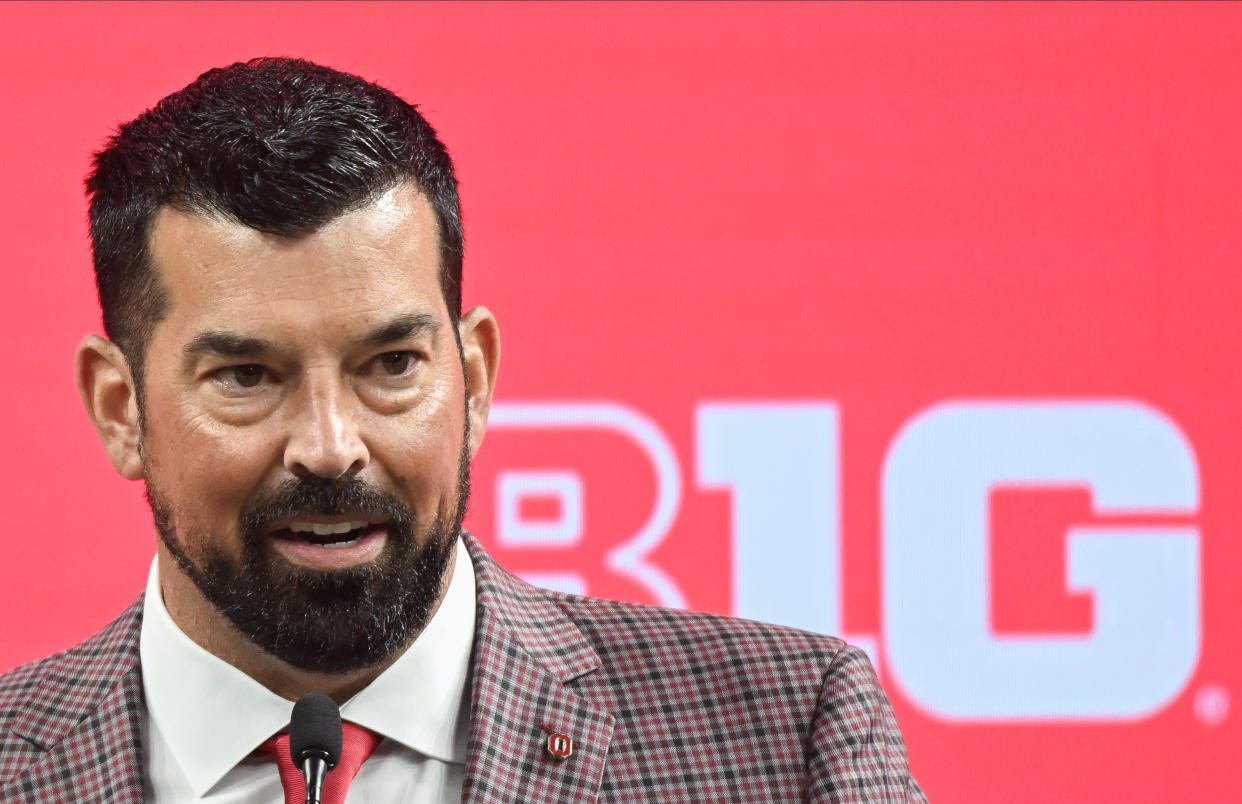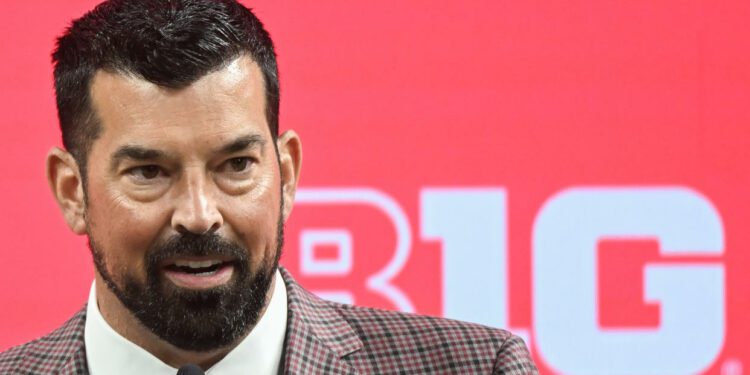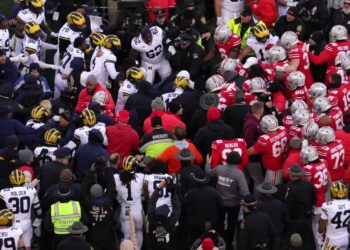INDIANAPOLIS — In his stylish checkered suit jacket and red tie, a cleanly cropped hairline and perfectly trimmed beard, Ryan Day strides across Lucas Oil Stadium and through Big Ten media days Tuesday like a CEO occupying the halls of a Fortune 500 company.
In many ways, he is CEO of a Fortune 500 company: Ohio State Football, Inc.
Last year, Ohio State produced the country’s largest athletic budget, $275 million, much of it from football-generated revenue. And soon the school, like all others, will be permitted to distribute that wealth directly to players.
In fact, the university is rich enough that its donor-led collective and brand affiliates disbursed to Buckeyes football players “around $20 million” this past year, said Ross Bjork, the Ohio State athletic director. In all likelihood, that figure ranks first in America.
But as college sports enters a new revenue-sharing model, a question looms for all schools, most notably the nation’s richest.
Will those numbers continue?
“It’s too early to predict,” Bjork said. “How is it going to be broken down from a Title IX standpoint? The challenge is, we’re up against the clock. We’re signing athletes in football in December. We need some clarity sometime this fall.”


Ohio State Buckeyes head coach Ryan Day speaks to the media during the Big Ten football media days at Lucas Oil Stadium in Indianapolis. (Robert Goddin-USA TODAY Sports) (USA TODAY Sports via Reuters Connect / Reuters)
On Day 1 of the three-day media gathering in downtown Indianapolis, the Big Ten’s behemoth took center stage. This season looms as most important for Day, the 45-year-old entering his sixth full season in charge, having lost three straight years to rival Michigan and not yet winning a national title.
While he’s won 56 games and lost eight, the expectation level in Columbus is quite lofty, this season especially. With such extravagant resources — perhaps the biggest football roster budget in all of college football — the goal is clear: win it all.
“We all know there is a lot of noise and hype around this team,” Day said Tuesday.
Off the field, the future remains murky.
The NCAA and power conferences are expected to file on Friday the long-form agreement in the landmark settlement of three antitrust cases — a document that outlines particulars around the two-part deal: the $2.77 billion in back pay to former athletes and the new model permitting schools to share upward of $20-plus million with athletes starting next fall.
How to distribute the revenue to athletes while balancing the federal Title IX law remains a vexing issue that the country’s richest athletic department continues to examine. Like many college leaders across the country, Bjork believes the formula used to distribute the back pay — as much as 90% may go to power conference men’s athletes — will serve as a “road map” for determining how schools will distribute revenue in the new system.
Plaintiff attorneys are expected to distribute the back pay — language that will be included in the long-form agreement — to mostly power conference football and men’s basketball players, they’ve said.
“We all are going to follow Title IX,” said Bjork. “It applies to our athletic programs, universities, all of those things. But this is a new pocket of financial aid or compensation, a new bucket that was not contemplated when only financial aid and just grant-in-aids were talked about in the original Title IX legislation. We need a lot of analysis. What does the legal analysis say around this newfound bucket of money?”
Ohio State is “modeling, analyzing and testing” different ways to distribute revenue against “legal analysis,” he said. Many other departments are conducting the same modeling. Can 80% of the annual revenue go to men and 20% to women? How about 70-30? Or does it need to be closer to a 50-50 split?
It remains a hazy issue, but both Bjork and his coach believe that any ratio should be the same or similar across the country.
“I think coming together and having some uniformity is the most important thing here,” Day told Yahoo Sports on Tuesday. “In terms of what that number is, that’s over my head. I know we need to be Title IX compliant at the same time. I think some uniformity is not unreasonable.”
Most provisions in the settlement give schools flexibility on various issues as localized decisions, a way for college leaders to remove the NCAA and conference from antitrust challenges. But perhaps an unwritten and loosely termed conference-wide mandate is possible.
“The question is, can it be some uniform standard across the country without getting ourselves into another legal entanglement?” asked Bjork.
This continues to be a topic of discussion in each power league, with administrators meeting weekly to deliberate on possibilities of distribution and Title IX’s influence. Big Ten conference commissioner Tony Petitti said the settlement’s expansion of scholarships gives schools “all kinds of opportunities,” which possibly includes additional women scholarships to balance out Title IX.
As part of the agreement, scholarship restrictions are being replaced by roster limits. Under the new model, schools can offer scholarships to each member of a roster. Football, with a current scholarship restriction of 85, will now have a roster limit of around 105. Baseball, with a scholarship restriction of 11.7 now, is expected to have a roster limit in the “mid-30s,” SEC commissioner Greg Sankey said last week.
Another key change to the scholarship structure: All sports will be considered “equivalency sports,” meaning partial scholarships can be distributed to players. Football, basketball and other sports are currently considered “head-count sports,” which required players on scholarship to receive a full grant. “In football, you will be able to put a kid on a 50% scholarship,” Bjork said. “You can’t do that now.”
Some leagues are already gearing up for specific revenue-sharing distribution amounts. In a story published last week from SEC media days, the conference’s coaches expected to share anywhere from $12 million-17 million with football players in the new revenue model, or about 70-75% of the cash allowable to be distributed.
However, the cost will rise significantly.
“Something overshadowed is this money goes up,” Bjork said. “Right now, we’re talking $21.5 million, but the second year, it goes up to $24 million and then it goes up, like, $1 million a year. We keep using a $22 million number, but we should really be talking $24-25 million.”
It’s true. But it’s also complicated.
The annual revenue-sharing cap is 22% of an average of power school athletic department revenue streams. The exact figure will remain uncertain until revenues from the 2024-25 academic year are uncovered, plaintiff attorneys told Yahoo Sports.
However, schools are anticipating that number to be, as Bjork noted, around $21.5 million in the first year of the system next fall. The number will, indeed, rise based on built-in increases as well as extreme revenue shifts, such as the addition of new College Football Playoff revenues starting in 2026. The cap can be reduced by as much as $5 million for schools that add scholarships and offer Alston-related payments.
One of the goals of the new revenue-sharing model is to shift payments to athletes from the booster-led collectives to the school directly.
While Bjork and Day meandered around media day Tuesday, Petitti expressed faith in the new model’s enforcement system. College leaders contend that the settlement-related injunctive relief grants them the ability to continue their near century-old fight to prevent performance-based pay for athletes through boosters. The settlement prohibits recruits or current athletes from entering into any arrangement with a booster unless the deal can be expressly proven as a genuine agreement for use of the player’s likeness.
“The settlement gives us the right to enforce against third-party pay-for-play,” Petitti said. “It’s incumbent on us to build a system that is fair for student-athletes to evaluate NIL deals, and I think there’s an opportunity to do that. It has to be built.”
The system is expected to include a clearinghouse to vet third-party NIL deals and a neutral arbiter — not the NCAA — to rule on any potential violations. Could this arbiter hold subpoena power? Petitti is unsure, but it’s possible.
Whether a third-party arbiter, the NCAA or a clearinghouse can slow booster-backed payments remains a massive question mark.
“If it’s a third party, that’d be great because (NCAA) enforcement has had a lot of challenges across the board,” Day said. “That would be the best way to do it.”
Meanwhile, Day is hot on the trail recruiting for the 2025 signing class — the first group of freshmen to receive direct revenue sharing from schools. With few answers, coaches and administrators — even from the country’s richest athletic department — are purposely vague with recruits.
“We’re telling them there’s going to be three buckets: traditional financial aid, revenue sharing and the name, image and likeness (NIL) category,” Bjork said. “What the NIL ecosystem looks like in the future is still to be determined, but those are basically the three categories of how you will receive (compensation). What those numbers are and what that looks like … no one can provide any clarity on right now.”
Source link : https://www.aol.co.uk/sport/player-pay-reaches-heights-ohio-134419550.html
Author :
Publish date : 2024-07-24 09:44:19
Copyright for syndicated content belongs to the linked Source.






